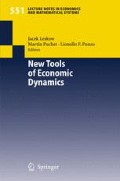Summary
In this paper, we apply a dynamic microsimulation approach, which allows us to examine the evolution of the system as a whole and at the same time to focus our attention on the different typologies of workers and pensioners. The latter objective is achieved by simulating individual reactions to systemic changes, while taking into account the regional dimensions. This technique also enables us to perform a general micro-analysis of the effects of past reforms on family pension-income distribution and average individual pension-benefits. The analytical framework used is the dynamic microsimulation model MIND, jointly developed by the University of Parma and Pisa, that incorporates behavioural analysis of individual choices of retirement age, derived from the Stock-Wise [24] option value model. We also perform sensitivity analysis on the model. This represents a valuable technique for treating uncertainty in input variables and for testing the robustness of the simulation results to possible changes in the macroeconomic scenario. In particular, we measure the economic impact resulting from alternative values of the income growth rate and the real interest rate as well as the effect of different distributions of the education degree reached by the individuals.
MIUR financial supports are gratefully acknowledged. We also thank an anonymous referee and the participants at the workshop New Tools for Qualitative Economic Dynamics held at the CIMAT, Guanajuato - Mex (October 2002) and VII WEHIA Workshop held in Trieste (May 2002) for helpful comments and suggestions.
Access this chapter
Tax calculation will be finalised at checkout
Purchases are for personal use only
Preview
Unable to display preview. Download preview PDF.
References
Aaron H (1966) The Social Insurance Paradox, Canadian Journal of Economics 32: 371–379
Atkinson AB (1983) The Economics of Inequality. Clarendon Press Oxford
Aaron H (1966) The Social Insurance Paradox, Canadian Journal of Economics 32: 371–379
Banca d’Italia (1997) I bilanci delle famiglie italiane nell’anno 1995. Supplemento al bollettino statistico 14, Banca d’Italia Roma
Bianchi C, Romanelli M, Vagliasindi P (2001) Inequality and poverty among pensioners: microsimulating the role of indexing lowest pensions to wages, ECOFIN Discussion Papers, Università di Parma
Bianchi C, Romanelli M, Vagliasindi P (2003) Validating a dynamic microsimulation model of the Italian households. In this volume
Cannari L, Nicoletti Altimari S (1998) A microsimulation model of the Italian household’s sector. In: Le previsioni della spesa per pensioni, ISTAT, Annuali di statistica, Serie 10, 16:103–134
Champernowne DG, Cowell FA (1998) Economic inequality and income distribution, University Press Cambridge
De Sandre P, Pinnelli A, Santini A (eds) (1999) Nuzialità e fecondità in trasformazione: percorsi e fattori del cambiamento, Il Mulino Bologna
Homer S, Sylla R (1991) A History of Interest Rate. Rutgers University Press London
Morrison R J (2000) DYNACAN, the Canada Pension Plan Policy Model: Demographics and Earnings Components. In: Gupta A, Kapur S (eds) Microsimulation in Government Policy and Forecasting, North-Holland Amsterdam
Neufeld C (2000) Alignment and Variance Reduction in DYNACAN. In: Gupta A, Kapur S (eds) Microsimulation in Government Policy and Forecasting, North-Holland Amsterdam
Shorrocks AF (1995) Revisiting the Sen poverty index. Econometrica 63:1225–1230
Stock JH, Wise DA (1990) Pensions, the option value of work, and retirement. Econometrica 58:1151–1180
Tucci MP (1998) Stochastic Sustainability. In: Chichilninsky G, Heal J, Vercelli A (eds) Sustainability: Dynamics and Uncertainty, Dordrecth, Kluwer ed., pp. 151–169
Vagliasindi P (1999) Riforma del TFR e futuro del sistema pensionistico. ECOFIN, Discussion Paper Series, n.2, Università degli Studi di Parma
Wolf DA (2001) The role of microsimulation in longitudinal data analysis. Papers in Microsimulation Series, N6, Syracuse University, Syracuse
Author information
Authors and Affiliations
Editor information
Editors and Affiliations
Rights and permissions
Copyright information
© 2005 Springer-Verlag Berlin Heidelberg
About this chapter
Cite this chapter
Bianchi, C., Romanelli, M., Vagliasindi, P.A. (2005). Policy Analysis Using a Microsimulation Model of the Italian Households. In: Leskow, J., Punzo, L.F., Anyul, M.P. (eds) New Tools of Economic Dynamics. Lecture Notes in Economics and Mathematical Systems, vol 551. Springer, Berlin, Heidelberg. https://doi.org/10.1007/3-540-28444-3_13
Download citation
DOI: https://doi.org/10.1007/3-540-28444-3_13
Publisher Name: Springer, Berlin, Heidelberg
Print ISBN: 978-3-540-24282-6
Online ISBN: 978-3-540-28444-4
eBook Packages: Business and EconomicsEconomics and Finance (R0)

